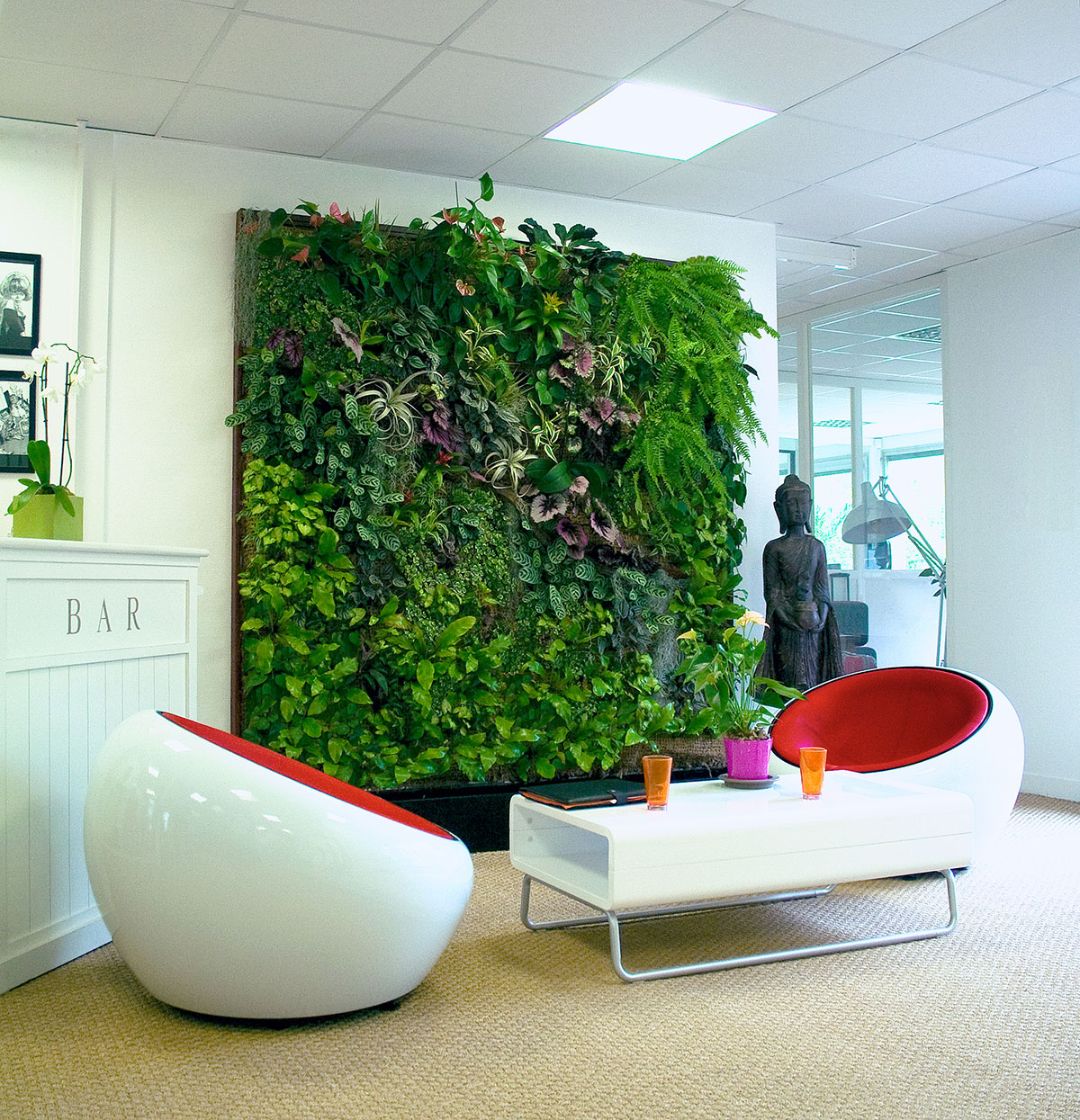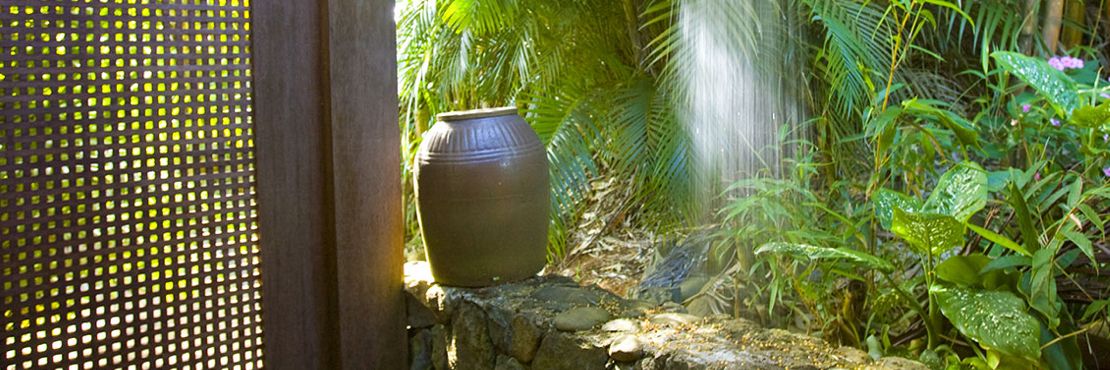As we stand near the dawn of a new decade, humans are more disconnected than ever from the natural environment. We spend most of our time away from nature, cooped-up inside our homes and offices. The natural environment plays a vital role in our mental and physical health. That’s why many designers are trying to bridge this disconnect by putting biophilic trends into modern buildings.

“Green Living Room” by Charly W. Karl, (CC BY-ND 2.0) with terrariums in the coffee table and within the large green wall.
What is Biophilic Design?
The theory of “biophilia” is the brainchild of Harvard ecologist and sociobiologist Edward O. Wilson, which he defined as “the urge to affiliate with other forms of life,” (Biophilia, 1984). Crediting Wilson for his early research confirming man’s need for nature, Yale social ecology professor Stephen R. Kellert, Ph.D. also helped pioneer the emerging theory. Wilson and Kellert both suggest mankind needs more than food and sustenance from the world around them. Kellert’s work includes Nature by Design: The Practice of Biophilic Design, 2018.
Biophilic design allows architects and designers to combine the natural and modern worlds. It’s a growing movement that interweaves natural and human-made elements into a construction. This design theory enables humans and nature to live and thrive together. If it doesn’t contribute to the health and productivity of the people within, it’s not a true biophilic design.

Mur végétal intérieur by Spaceo, CC BY-SA 3.0, Wikimedia Commons.
Design with Purpose
Think of it as bringing the outdoors indoors or viewing nature from inside – not for decorative or aesthetic reasons, but solely for re-connecting humans with the natural world for the betterment of humanity.
While living together in biophilic harmony, the hope is that interacting with nature makes people happier and healthier. It is a reminder that modern technology and nature do not have to be mutually exclusive. Humans have always been able to survive by adapting to their environments, and incorporating biophilia is the next big step in designing with purpose.

Outdoor Shower by harley photo, CC BY-SA 3.0, Wikimedia Commons.
Biophilic Features
Biophilic design isn’t just about planting a bunch of trees to give the appearance of the outside environment. It’s supposed to mimic aspects of the natural environment from the light, the weather, the smells, the sounds, the touch, and even animal life.
- Natural Light: Using light and shadow to mimic being in a forest or shady park can make you feel like you don’t have a roof over your head.
- Airflow: Feeling the wind on your skin is part of being outside. Bringing that inside adds to the Biophilic aspect of your space. Airflow can be incorporated using natural or artificial means.
- Weather: The sounds, the smells, and the feel of rain can all be brought inside with a waterfall or simulated rain. Add some humidity, and you’d swear you were typing your expense reports in a jungle.
- Sounds: Sounds that simulate the natural world can be as simple as wind noise rustling through the trees in the atrium. You could also incorporate recordings of birds and rain falling.
- Plants: Bringing plants indoors isn’t new but, unless there are enough of them to impact the environment, it’s not biophilic. Incorporating plant life in architectural design is one of the pillars of biophilic designs. Atriums that mimic forests, green roofs, and green walls are all great ways to connect with nature every day and stimulate all your senses.

Casa Vallarta Greenroof & Greenwalls. Image: Greenroofs.com courtesy of Cynthia Villalba, Zona Verde MX.
Green Roof Designs
As we know, green roofs are a popular way to incorporate biophilic design on many types of buildings. Whether it’s atop the tallest skyscraper or your own home, green roofs have significant benefits. Not only can they reduce runoff into sewers and naturally cool your home but green roofs will also save on your energy bill while you appreciate nature.
- City Hall, Chicago: Built-in 1911 and redesigned in 2001 with its now famous green roof, the Chicago City Hall has more than 150 species of plants and flowers. You’ll also notice two trees on the roof garden. Standing on the roof makes you feel like you’re living in dual worlds. You have nature at your feet in the shadows of modern skyscrapers.
- Autofamily House, Poland: This fascinating eco-friendly house moves the garage into the house. (Assuming your car is electric.) The green roof makes the house look like it’s emerging from under the ground, and adds to the yard.

Image: pixabay
Green Walls In Architecture
Another way to enhance our building footprint is to install vertical gardens or green walls. These can be either on the exterior of a building or inside, and consulting with a professional designer or system supplier is recommended. Traditional walls and fences can reflect sunlight and make it feel even hotter on a patio. Green walls can cool a building down by several degrees on hot days and create a clean atmosphere inside.
- At home: Installing a green wall in your home can add a lot of benefits, and depending on your desired outcome and skill level, and a small do-it-yourself type living wall could be a fun project for the whole family. A green wall will turn heads and be the center of the conversation. Not only are they visually pleasing but they clean the air and naturally cool your house. Just be sure that your green wall is structurally sound and gets enough sunlight, either natural or artificial. Other factors to consider are automatic versus hand irrigation and fertilization. Do your homework to find out the basic requirements of green walls before starting on a DIY project.
- One Central Park, Australia: Designed by French botanist Dr. Patrick Blanc, this multi-use development project contains hydroponic living walls and green façades plus a heliostat feature placed strategically to reflect sunlight from the underside of the building’s green roof. In addition to the living architecture elements, this project emulates biophilia in a unique way by altering traditional features like the use and display of the reflectors.
- Casa Vallarta, Mexico: An example of utilizing both a green roof and green walls, the Casa Vallarta in Mexico is a stunning achievement in biophilic design. This building truly is one with nature.
Pioneering architects will be at the forefront of integrating biophilic design into the modern landscape. As biophilic architecture catches on as more of a necessity than vanity, it can have a huge impact on our climate as well.

The Spheres within the Amazon Headquarters in Seattle. Image: JORDAN STEAD / Amazon
We can greatly reduce our ecological footprints by enhancing the spaces we took for our homes and offices with living elements. Tar and shingle roofs can turn into yards and masonry walls into vertical gardens while fences can be turned into hanging gardens. Even urban office environments can mimic a rain forest with biophilic design, turning conventional architecture inside-out.
~ Tony Steine
Tony Steine is a lawn and garden writer for LawnStarter Lawn Care. Tony prides himself on finding the easiest way to do anything he can, and you can bet he’s tried to make his entire garden self-watering. Of course, he isn’t just about convenience either, adding a unique design flair to everything he does.
Contact Tony at:
Phone: (361) 879-2646
Email: tony@lawnstarter.com
 Greenroofs.comConnecting the Planet + Living Architecture
Greenroofs.comConnecting the Planet + Living Architecture










Ely Sava
It is intriguing to learn about Biophilic design where there is a fusion of nature with architectural design. I find there are many common attributes to Feng Shui as both creates positive air flow and emanate harmony and serenity. Thank you for enlightening us on this topic.
Harry Vinston
A great introduction on how well architecture and landscaping goes together. Very informative read. Also do check out our sites that offers one of the best Hvac Services HVAC Services
Do Not Hire An Expensive Service Provider! Use These Tips For Taking Care Of Your Roofing System Rather! – The Love of Liu 495
[…] come loose. One missing shingle could eventually lead to thousands of dollars in damages. To make https://www.greenroofs.com/2019/02/20/biophilia-turning-conventional-architecture-inside-out/ that this does not happen to you, you should check your roof once a month for any shingles that may […]
A Quick Review Of Roof Covering Installment Refine – The Life of Ramirez 002
[…] to keep in mind that asphalt shingles are not the most convenient roof item to install.When top roofing contractors identify which roof products you are mosting likely to use for your roofing job, you will want to […]
Learn All That You Required To Pick The Perfect Roof Business – The Blogging of Mullen 133
[…] to several different people and see what your options are. In general, five bids is a good number. https://www.greenroofs.com/2019/02/20/biophilia-turning-conventional-architecture-inside-out/ than that, and you are probably selling yourself short.There are please click the next internet […]
Roof Tips You Can Beginning Using Today – The Journaling of Hodge 860
[…] trouble spot. Chimneys move over time which can damage the roofing materials around it. Check https://www.greenroofs.com/2019/02/20/biophilia-turning-conventional-architecture-inside-out/ around the chimney for gaps that can cause leaks. The older your chimney is, the more likely you […]